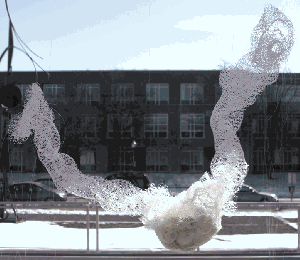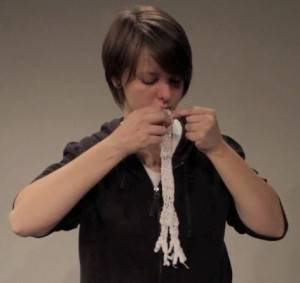 It’s not often that someone uses crocheted thread as the media to depict a neuron in the human body, but that’s kind of the point of the current art exhibit “System Imaging” at indi go art gallery in downtown Champaign. The exhibit runs until this Friday, December 3rd on the lower level of the gallery. There’s also a reception for the exhibit on Friday evening. Gallery hours and other details are available on the indi go website.
It’s not often that someone uses crocheted thread as the media to depict a neuron in the human body, but that’s kind of the point of the current art exhibit “System Imaging” at indi go art gallery in downtown Champaign. The exhibit runs until this Friday, December 3rd on the lower level of the gallery. There’s also a reception for the exhibit on Friday evening. Gallery hours and other details are available on the indi go website.
The exhibit features a number of illustrations of various aspects of the human body using different materials ― one piece uses resin, human hair, porcelain, and wax, for instance. There’s a piece showing a brain made from felt, collages of body parts that aren’t immediately related in ink, and more.
From the exhibit literature:
“System Imaging” is a collection of hand-made alternatives to scientific images of the human body. Familiar materials and conventional means of art-making remove the body from a traditional academic context. The resulting works are simplified illustrations of complex physical processes.
I spoke recently with exhibit artists and curators Andrea Jennings and Anna Katherine Peters, along with Nicki Werner, one of the featured artists, about what they are trying to accomplish here. All three study art currently at the U of I, or have studied it there in the past, although the exhibit is not affiliated with the university. “It wasn’t homework,” said Jennings.
Raising questions
One thing the artists say they are trying to do is simply raise questions about the body — how it’s portrayed, and how we see it. Peters said, “If I can crochet a neuron that’s a million times bigger than a real one and still kind of have it look very similar, then how much can we really know? And we haven’t come up with an answer, but we’re putting the question out there.”
The artists believe that when you see an illustration in a medical textbook, it’s just another interpretation of the body itself — not reality. “There’s a translation happening; it’s not a direct thing,” Peters said. “The stuff that we grew up with in textbooks all the way up to Gray’s Anatomy…the images in these books are not necessarily direct translations of what we actually are. I think we’re just interested in other ways of trying to explore or understand it.”
Jennings elaborated, “There’s an interpretation in a scientific illustration, and then there’s our interpretation of those images.” She continued, “We’re interpreting the actual body parts in a way that makes sense to us as artists.”
By using everyday media, the artists feel that they’re showing the body in a more comforting way than it is normally portrayed: “Going to the doctor is scary,” said Peters. “And it’s not doing anyone a service to always display the body with cold digital media. Everyone’s grandma has doilies — we want to make it a little more accessible.”
A Critique of academic illustration?
I pointed out that if you’re truly sick, you want the best scientific images of what’s wrong with you, not necessarily the most everyday and homely. The artists agreed. Peters said, “We’re not in any way saying this is better than scientific illustration or that scientific illustration needs to be more like this. We’re just trying to fill in the gaps.”
Werner added, “If you need surgery, go to the doctor, but if you’re sad maybe look at this.” She continued, “I would say that there are strong moments of critique, but that it’s also about presenting an alternative — although not necessarily a better one. We’re just saying that there’s another way of understanding.”
The artists used medical textbooks and other traditional modes of scientific illustration to work off of for models and inspiration. Everything in the exhibit seems to be more or less medically accurate.
Werner explained, “It’s not so much about seeing an alternative as experiencing an alternative — how we start to understand the body in ways that don’t pretend to be fact.”
Jennings feels that art offers a way of “filling in the gaps” of how the body is traditionally portrayed in academic imagery: “Also there’s the idea that thoughts and moods and emotions can’t be shown in that imagery and historically, that’s where the artist has come in — to explore those kind of abstract ideas.”
Personal interpretation
The artists seem to feel that the human body is a mysterious thing, and because they’re artists, creating art is their way of trying to make sense of that mystery. “I feel that a lot of how we understand something is through making,” said Peters.
I asked whether the exhibit is medical art or fine art? “It’s fine art,” replied Peters. “I would say our audience would include scientists too, almost more importantly scientists.”
“Breathing a Doily Into My Trachea”
 By far the most startling piece in the exhibit is by Werner, and is called “Breathing a Doily into My Trachea.” The piece is a video of Werner attempting to do just that. She made an anatomically correct doily of a trachea using a medical textbook as a guide and, in the video, tries to inhale it into her own trachea. She doesn’t quite get the doily all the way down her trachea.
By far the most startling piece in the exhibit is by Werner, and is called “Breathing a Doily into My Trachea.” The piece is a video of Werner attempting to do just that. She made an anatomically correct doily of a trachea using a medical textbook as a guide and, in the video, tries to inhale it into her own trachea. She doesn’t quite get the doily all the way down her trachea.
Werner claimed that trying to inhale a trachea-shaped doily isn’t as dangerous as it might seem: “I had to do a lot of research about the body and the difference between the trachea and the esophagus. There are all kinds of yoga and medical practices where they swallow cloth into the esophagus and pull the cloth out as a cleaning thing. I learned that it’s about breathing and not swallowing. That’s why I’m trying to breathe it into my trachea. I knew that I could gag or throw up, and it was painful, but I wasn’t in any danger.”
Why? What kind of statement was she trying to make, I asked.
Werner responded: “I wouldn’t say it’s a statement. I think that’s too strong. I think it was about me trying to understand doilies. I was thinking about the whole history of doilies being objects that prevent wear and tear on things — scratches and things — but they are something that women have labored over intensely. A lot of my work deals with women’s crafts and labors and there’s always value in looking at that. So, I don’t know all the way what the piece is about. I was trying to understand what it would mean — this idea of having this doily in my trachea.”
~~*~~
Feature photo: “Nervous Circulatory Systems,” by Anna Peters








